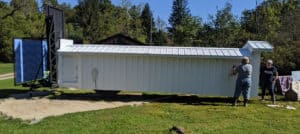Share this article
Glass patterns deter birds from deadly building crashes
Creating patterns on glass by adding material or making etchings can drastically reduce the danger buildings pose to birds, according to new research in which scientists used a novel device to test the animals’ detection abilities.
“You have to put these details on windows with spacing that is going to seem to the birds like solid elements, and they don’t think they can pass through the spaces between them,” said Christine Sheppard, director of the Glass Collisions Program at the American Bird Conservancy and the author of a study published recently in Global Ecology and Conservation.
She and her co-authors calculated that an average of 599 million birds are killed in the U.S. every year from striking windows. That’s about two birds per regular home every year, 22 per low rise building and 24 per high rise building.
The team wanted to find a way to test what people could do to glass to stop birds from crashing into it. Sheppard had been following the experiments at the Hohenau-Ringelsdorf Biological Station in Austria for some time that tested different glass patterns for bird visibility. With the help of funding from the Association of Zoos and Aquariums’ Conservation Endowment Fund, she set out to create a similar “testing tunnel” at Carnegie Museum’s Powdermill Avian Research Center in Pittsburgh.
In these devices, the birds start at the bottom of the Y-shaped tunnel and see two ways to reach the end. Each exit is fitted with a glass pane with different patterns to see which was more or less visible to the birds (the birds are blocked from actually striking the glass by mist netting). The researchers determine which glass is more visible based on which way the birds don’t fly.
The researchers found a number of different things that worked to deter birds. One of the most effective was putting patterns on the glass. This can be done by sticking tape or other materials on the window, but it can also be done by etchings carved into the glass by the manufacturers.

The Testing Tunnel at Carnegie Museum’s Powdermill Avian Research Center in Pittsburgh helps determine which types of glass are more likely to deter birds. Courtesy of Powdermill Avian Research Center
When it comes to patterns, usually the ones that are the most effective are details close enough together to make the birds realize it’s a solid surface they are potentially flapping toward.
Sheppard stressed that while glass manufacturers that provide material for skyscrapers and other massive building projects will be able to grade the bird safety of their products in the future by using this device, ordinary people can also take relatively cheap and easy steps to improve the safety of their home windows to bird.
Steps like this are important since the researchers calculated that about 44% of all birds that die from striking windows are at people’s homes. These steps include can include putting down the curtains or using stickers such as Halloween decorations to deter birds.
“There are tons of things people have done for years that people didn’t intend to be bird friendly but that are friendly,” Sheppard said.
While the researchers learned a lot about the specific spacing that is most effective to deter bird strikes, Sheppard said that research is ongoing as manufactures and researchers come up with new ideas for bird-friendly technology. She hopes lawmakers will enact legislation to enforce the use of more bird-friendly glass.
“We’re trying to educate the people that are making the decisions,” she said.
Header Image: Building glass is a common cause of mortality for birds. ©historyworks








